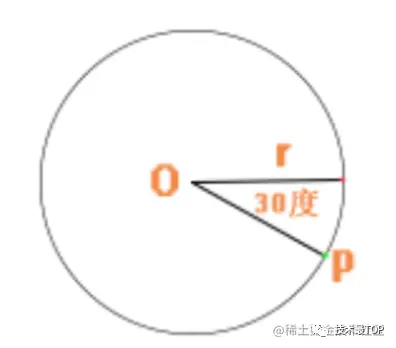炫酷!自定义View实现Dribbble上动感的Gallery App Icon 动画!
之前在dribbble看到一个很好看的动画效果,很想要,遂仿之。也为了练一下自定义控件,有段时间了,现在整理出来

思路
拆解一下,还是比较简单,需要绘制的有:
- 圆形背景
- 太阳(圆形)
- 山(三角形)
- 云朵(圆角矩形 + 三个圆)
需要进行的动画:
- 太阳 - 旋转动画
- 山 - 上下平移动画
- 云朵 - 左右平移动画
不必绘制圆角外框,因为各个手机厂商的应用icon的圆角不一样,我们可以在Android Studio里生成应用图标。如果有必要也可以自己使用shape画出来。
其中难处是进行太阳的动画和绘制云朵,因为太阳的旋转动画需要计算旋转的圆上点的坐标,而云朵的形状是不规则的。
绘制
1.圆形背景

onDraw()方法里使用canvas.drawCircle():
@Override
protected void onDraw(Canvas canvas) {
super.onDraw(canvas);
// 将View切成圆形,否则绘制的山和云朵会出现在圆形背景之外
mRoundPath.reset();
mRoundPath.addCircle(mViewCircle, mViewCircle, mViewCircle, Path.Direction.CW);
canvas.clipPath(mRoundPath);
// 绘制圆形背景
canvas.drawCircle(mViewCircle, mViewCircle, mViewCircle, mBackgroundPaint);
}这里的mViewCircle是指view的半径;mBackgroundPaint是用来画背景色的Paint。
mViewCircle获取:
@Override
protected void onSizeChanged(int w, int h, int oldw, int oldh) {
super.onSizeChanged(w, h, oldw, oldh);
// 取宽高的最小值
mParentWidth = mParentHeight = Math.min(getWidth(), getHeight());
// View的半径
mViewCircle = mParentWidth >> 1;
}mBackgroundPaint背景色设置一个颜色就好:
mBackgroundPaint = new Paint(Paint.ANTI_ALIAS_FLAG);
mBackgroundPaint.setColor(mBackgroundColor);其中如果不将View切成圆形会出现的情况为:
2.绘制太阳和进行旋转动画

canvas.drawCircle((mParentWidth / 2) - getValue(90), (mParentHeight / 2) - getValue(80), sunWidth / 2, mSunPaint);
但是我们要加上动画,这时候我们需要了解到:
/**
* Transform the points in this path by matrix, and write the answer
* into dst. If dst is null, then the the original path is modified.
*
* @param matrix The matrix to apply to the path
* @param dst The transformed path is written here. If dst is null,
* then the the original path is modified
*/
public void transform(Matrix matrix, Path dst) {
long dstNative = 0;
if (dst != null) {
dst.isSimplePath = false;
dstNative = dst.mNativePath;
}
nTransform(mNativePath, matrix.native_instance, dstNative);
}该方法可以将一个path进行matrix转换,即矩阵转换,因此我们可以通过方法matrix.postTranslate来实现平移动画,即创建一个循环动画,通过postTranslate来设置动画值就可以了。
/**
* Postconcats the matrix with the specified translation. M' = T(dx, dy) * M
* dx,dy,是x,y坐标移动的差值。
*/
public boolean postTranslate(float dx, float dy) {
nPostTranslate(native_instance, dx, dy);
return true;
}
复制代码
我们先在onSizeChanged()里得到起始点太阳圆心的x,y坐标,然后再在onDraw()里实时获取要旋转时的x,y坐标,最后得到对应的差值。
onSizeChanged()里绘制太阳和得到旋转时起始点的x,y坐标:
private void drawSun() {
// sun图形的直径
int sunWidth = getValue(70);
// sun图形的半径
int sunCircle = sunWidth / 2;
// sun动画半径 = (sun半径 + 80(sun距离中心点的高度) + 整个View的半径 + sun半径 + 20(sun距离整个View的最下沿的间距)) / 2
mSunAnimCircle = (sunWidth + getValue(100) + mViewCircle) / 2;
// sun动画的圆心x坐标
mSunAnimX = mViewCircle;
// sun动画的圆心y坐标 = sun动画半径 + (整个View的半径 - 80(sun距离中心点的高度) - sun半径)
mSunAnimY = mSunAnimCircle + (mViewCircle - getValue(80) - sunCircle);
// 得到圆形旋转动画起始点的x,y坐标,初始角度为-120
mSunAnimXY = getCircleXY(mSunAnimX, mSunAnimY, mSunAnimCircle, -120);
// 绘制sun
mSunPath.addCircle(mSunAnimXY[0], mSunAnimXY[1], sunCircle, Path.Direction.CW);
}其中稍微困难点的是得到圆上的x,y坐标 getCircleXY():

(mSunAnimX,mSunAnimY)、半径为sunCircle、角度angle = -120度
(角度是相对于图中横线,顺时针为正,逆时针为负),要计算p点的坐标(x1,y1)有如下公式:
x1 = x0 + r * cos(angle * PI / 180)
y1 = y0 + r * sin(angle * PI /180)其中angle* PI/180是将角度转换为弧度。
/**
* 求sun旋转时,圆上的点。起点为最右边的点,顺时针。
* x1 = x0 + r * cos(a * PI /180 )
* y1 = y0 + r * sin(a * PI /180 )
*
* @param angle 角度
* @param circleCenterX 圆心x坐标
* @param circleCenterY 圆心y坐标
* @param circleR 半径
*/
private int[] getCircleXY(int circleCenterX, int circleCenterY, int circleR, float angle) {
int x = (int) (circleCenterX + circleR * Math.cos(angle * Math.PI / 180));
int y = (int) (circleCenterY + circleR * Math.sin(angle * Math.PI / 180));
return new int[]{x, y};
}然后我们在onDraw()里可动态得到圆上的其他点的x,y坐标达到旋转的效果:
// x y 坐标
int[] circleXY = getCircleXY(mSunAnimX, mSunAnimY, mSunAnimCircle, mSunAnimatorValue);
mSunComputeMatrix.postTranslate(circleXY[0] - mSunAnimXY[0], circleXY[1] - mSunAnimXY[1]);
mSunPath.transform(mSunComputeMatrix, mSunComputePath);
canvas.drawPath(mSunComputePath, mSunPaint);
复制代码
mSunAnimatorValue为变化的角度[-120,240]。这样就可以执行太阳的旋转动画:
/**
* sun的动画
*/
private void setSunAnimator() {
ValueAnimator mSunAnimator = ValueAnimator.ofFloat(-120, 240);
mSunAnimator.setDuration(2700);
mSunAnimator.setInterpolator(new AccelerateDecelerateInterpolator());
mSunAnimator.addUpdateListener(new ValueAnimator.AnimatorUpdateListener() {
@Override
public void onAnimationUpdate(ValueAnimator animation) {
mSunAnimatorValue = (float) animation.getAnimatedValue();
invalidate();
}
});
mSunAnimator.start();
}3.山和上下平移动画

在onSizeChanged()里绘制三座山和得到要平移的y坐标:drawMou(mViewCircle, mViewCircle - getValue(10), getValue(10));
/**
* 画中间的三座山
*
* @param x 中心点左坐标
* @param y 中心点右坐标
*/
private void drawMou(int x, int y, int down) {
// 左右山 Y坐标相对于中心点下移多少
int lrmYpoint = down + getValue(30);
// 左右山 X坐标相对于中心点左移或右移多少
int lrdPoint = getValue(120);
// 左右山 山的一半的X间距是多少
int lrBanDis = getValue(140);
// 中间山 山的一半的X间距是多少
int lrBanGao = getValue(150);
// 左山
mLeftMountainPath.reset();
// 起点
mLeftMountainPath.moveTo(x - lrdPoint, y + lrmYpoint);
mLeftMountainPath.lineTo(x - lrdPoint + lrBanDis, y + lrmYpoint + lrBanGao);
mLeftMountainPath.lineTo(x - lrdPoint - lrBanDis, y + lrmYpoint + lrBanGao);
// 使这些点构成封闭的多边形
mLeftMountainPath.close();
// 右山
mRightMountainPath.reset();
mRightMountainPath.moveTo(x + lrdPoint + getValue(10), y + lrmYpoint);
mRightMountainPath.lineTo(x + lrdPoint + getValue(10) + lrBanDis, y + lrmYpoint + lrBanGao);
mRightMountainPath.lineTo(x + lrdPoint + getValue(10) - lrBanDis, y + lrmYpoint + lrBanGao);
mRightMountainPath.close();
// 中山
mMidMountainPath.reset();
mMidMountainPath.moveTo(x, y + down);
mMidMountainPath.lineTo(x + getValue(220), y + down + mParentHeight / 2 + mParentHeight / 14);
mMidMountainPath.lineTo(x - getValue(220), y + down + mParentHeight / 2 + mParentHeight / 14);
mMidMountainPath.close();
// 左右山移动的距离
mMaxMouTranslationY = (y + down + mViewCircle) / 14;
}然后我们在onDraw()里根据动态的y坐标去移动,以中间的山为例:
// 中间的山
mMidComputeMatrix.reset();
mMidComputePath.reset();
mMidComputeMatrix.postTranslate(0, mMaxMouTranslationY * mMidMouAnimatorValue);
mMidMountainPath.transform(mMidComputeMatrix, mMidComputePath);
canvas.drawPath(mMidComputePath, mMidMountainPaint);让mMidMouAnimatorValue变化,注意y坐标会先上升一点再下降:
/**
* 中间山的动画
*/
private void setMidMouAnimator(final boolean isFirst) {
ValueAnimator mMidMouAnimator;
if (isFirst) {
mMidMouAnimator = ValueAnimator.ofFloat(0, -1, 10);
mMidMouAnimator.setStartDelay(200);
mMidMouAnimator.setDuration(1000);
} else {
mMidMouAnimator = ValueAnimator.ofFloat(10, 0);
mMidMouAnimator.setStartDelay(0);
mMidMouAnimator.setDuration(600);
}
mMidMouAnimator.setInterpolator(new AccelerateDecelerateInterpolator());
mMidMouAnimator.addUpdateListener(new ValueAnimator.AnimatorUpdateListener() {
@Override
public void onAnimationUpdate(ValueAnimator animation) {
mMidMouAnimatorValue = (float) animation.getAnimatedValue();
invalidate();
}
});
mMidMouAnimator.start();
}4.云朵和左右平移动画

想要深入了解的可看这里:Android 自定义View之下雨动画 - 画云。总的来说是由四块view组成,底部的矩形(因为整体下移了所以这里基本没有看到矩形),还有矩形上面的三个圆形。
// 绘制圆角矩形
path.addRoundRect(RectF rect, float rx, float ry, Direction dir)
// 绘制圆形
path.addCircle(float x, float y, float radius, Direction dir)然后得到x坐标后根据增量值mCloudAnimatorValue进行动态移动:
mCloudComputeMatrix.postTranslate(mMaxCloudTranslationX * mCloudAnimatorValue, 0);
mCloudPath.transform(mCloudComputeMatrix, mCloudComputePath);
canvas.drawPath(mCloudComputePath, mCloudPaint);然后我们将太阳的旋转动画、三座山的上下平移动画、云朵的左右平移动画,这五个动画组合起来就得到了一个完整的连贯动画。
最后
为了扩展性,我们给View增加一些属性,用来自定义颜色:
<declare-styleable name="SceneryView">
<!--The color of sun-->
<attr name="sun_color" format="color" />
<!--The color of the cloud-->
<attr name="cloud_color" format="color" />
<!--The color of the left mountain-->
<attr name="left_mountain_color" format="color" />
<!--The color of the right mountain-->
<attr name="right_mountain_color" format="color" />
<!--The color of the middle mountain-->
<attr name="mid_mountain_color" format="color" />
<!--The color of the background-->
<attr name="background_color" format="color" />
</declare-styleable>这里的主要难点是动画的理解和使用:
matrix.postTranslate(dx, dy);
path.transform(matrix, momputePath);
canvas.drawPath(momputePath, mPaint);我们通过动态改变dx和dy的值来达到动的效果,然后就是绘制三角形、圆形、圆角矩形以及它们坐标位置的动态处理。
